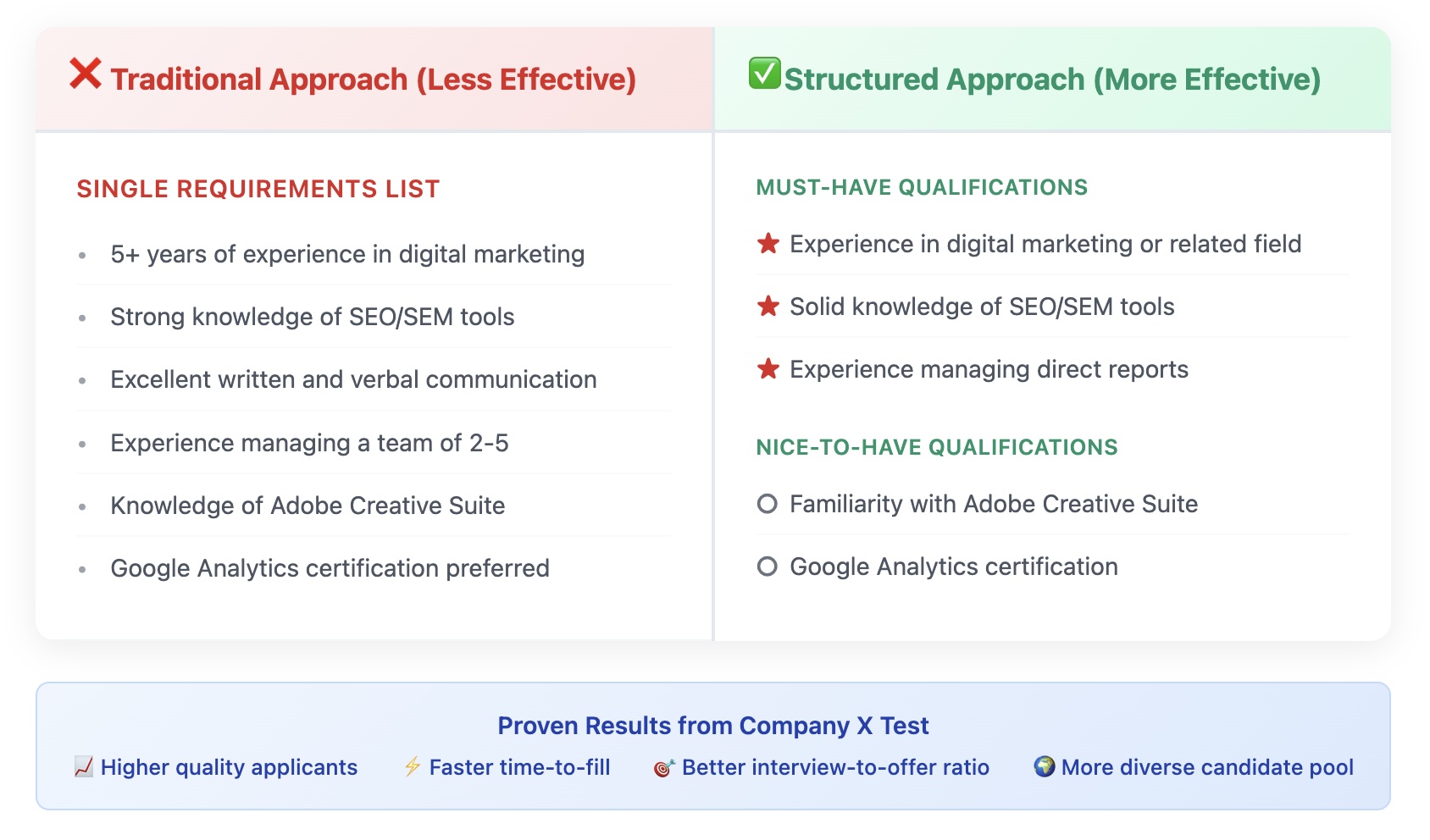Does your company have an established, formalized employee development strategy in place? Or do you let employees essentially decide what skills they should pursue (and how)? If it’s the latter, you might be missing out on a ton of opportunities that lead to more revenue company-wide. About 218% more revenue. And it’s not just about the money. Most employees agree that workplace training is great for keeping them engaged.
So how do you ensure employees aren’t failing to achieve their development goals? How do you build a strategy that works for everyone?
Here’s how.
Key takeaways:
- Employee development is a win-win. Employees are eager to learn and companies benefit from their growth.
- Specific, well-defined goals are at the core of any employee development efforts. Vague goals are harder to achieve.
- Misalignment between employee goals and company objectives is a serious challenge in building an employee development strategy.
- Analyzing your existing employee development strategy is crucial. This involves measuring metrics like employee retention as well as seeking out feedback.
- Strong employee development goals are specific, measurable, attainable, relevant, and time-bound.
Understanding employee development goals
Through employee development, employees can build new skills and level up existing ones. This includes the initial on-the-job training that teaches the hard skills needed for a specific role as well as soft skills and a primer on institutional knowledge. But employee development doesn’t—and shouldn’t—stop there.
Giving employees opportunities to build up their skills over their tenure means they can take on more complex work and help uncover new opportunities for the company at large.
It’s not just a win for the company, though. 74% of employees are eager to learn new skills and 94% say development opportunities would make them stay in their role.
As long as employees are pursuing goals that combine their vision for their career development with the organization’s broader needs, then employee development is a win-win. These goals should also meet the following criteria:
- They’re clearly defined and communicated.
- They use at least one metric to gauge success.
- Employees can achieve them in the time they’re given.
- They track with broader team and/or organizational priorities.
So if employee development is such a win-win, why is it often such a struggle? And why do so many organizations fail to see results after investing in their employee development strategy?
Common pitfalls in achieving employee development goals
Grit and determination aren’t always enough to reach your goals. Sometimes, the goal itself is the issue; it was never particularly realistic or achievable. Sometimes, the methods used to chase that goal aren’t adequate.
Extrapolate this to a company-wide employee development strategy, and you can already start to see challenges emerge. Here are just a few of them.
Lack of clear objectives
One of the biggest reasons goals fail isn’t the amount of effort being put toward that goal; it’s the goal itself. You can put twice as much effort into a vague goal and get half as far as you would with a clearly defined objective.
Whether your strategy puts the responsibility of setting goals in the employee’s court or their manager’s, it should ensure those goals are clear and achievable.
Here are some examples of vague goals:
- Become a better salesperson: This goal has a few problems. It doesn’t define what makes a better salesperson, well, better. What specific skills do you need to attain? How will you know you’ve become “better?”
- Learn how to run a marketing campaign: This is a more specific skill than just being a better salesperson, but it’s still too vague. What kind of marketing campaign will you be running? Are you leading the project or executing specific tasks? What do you need to learn to reach this goal?
- Grow communication skills: While communication skills are crucial, this goal doesn’t really specify what skills will be learned or how success will be measured.
A vague goal can lead to an employee putting a ton of effort into their development while never achieving any measurable progress. That’s enough to frustrate anyone.
Inadequate employee development training
If your goals are specific and measurable, the next challenge you might run into is the training itself. What sort of training does your organization offer? Is it suited to the employee’s specific development goal? Are there regular check-ins to ensure employees are making progress toward their goal?
You need a robust training plan to help employees achieve their development goals. A one-size-fits-all approach isn’t going to cut it, either, since training someone for their role in their first three months isn’t the same as helping a senior team member add new skills to their repertoire.
When working on a training plan, you should keep these common challenges in mind:
- Information overload: Too many training plans overwhelm employees with a ton of information and not much time to process it or integrate it into their existing skill set.
- Irrelevant training: While a training plan should have some flexibility, sometimes that flexibility is pushed beyond its limits, creating a plan that isn’t suited to an employee’s specific goal. That can lead to a lot of wasted time and resources as employees struggle to meet goals with inadequate training.
- Front-heavy training: You could have the best training in the industry, but without any follow-up, you won’t see much success. That’s because the majority of skills aren’t really learned in training sessions; they’re learned through practice and experimentation. A training program that doesn’t follow and support employees as they put new skills into practice isn’t going to have the best success rate.
Missing goal alignment
Helping employees achieve their goals is essential to your company’s growth. But unless those goals are aligned with the organization’s broader goals, a win-win strategy just becomes a win-lose at best.
Learning new skills and developing existing ones takes a significant amount of time and resources. Too often, though, those skills don’t contribute to an employee’s growth within the organization or to strategic objectives. That means a lot of those resources don’t bring any returns. An employee might have brand new skills that don’t really bring much value to their team, or they might find themselves unable to contribute to the company’s growth in a meaningful way.
Just because an employee is interested in a particular sort of training doesn’t mean they should always pursue it. Likewise, a team that’s convinced they need a certain skill set might not be aware of an impending organizational shift that will make those skills irrelevant. Your employee development strategy should have a built-in framework for keeping individual training goals, team goals, and organizational goals aligned.
Analyzing your current employee development strategy
How successful is your employee development strategy? Does it usually lead to progress? Can it determine how an employee’s stated development goal matches up with your company’s broader objectives? These are just a few of the questions you should be asking about your current strategy before you try to make any improvements.
Not sure where to start? Here are a few things you can measure to know where you stand.
- Employee engagement and satisfaction: Just like a software product might ask a user how satisfied they are, your training materials should have some built-in method for getting feedback. If you’re using slide decks and expert presenters, they might just ask trainees to answer a few questions either right there or through an emailed form. If you use dedicated training tools, they might do this automatically.
- Core competencies: Do you ask your employees to self-assess their skill level? If you do, how often do they review their skills? With this simple two-step process, you can easily track how successful your employee development efforts are. You can evaluate progress organization-wide or drill down on specific employees to see how their skills have evolved.
- Employee retention and turnover: Continuous development and internal mobility have an important impact on employee retention and turnover. When using this as a metric to evaluate the effectiveness of your employee development strategy, you’ll need to control for other factors, from overall morale to seasonality. But once you do, you can determine if your strategy has the positive impact on retention and turnover that it should have.
- Return on investment (ROI): If you get down to the pure monetary aspect of training employees, you can establish a direct link between the amount you put into employee development and how much revenue each employee brings in. After all, as you invest in employees and their skills, they should help the company generate more revenue. So if you see your revenue per employee increase by a greater margin than what you’ve invested in their development, you’re getting a return on your investment.
- Qualitative feedback and surveys: While quantitative metrics are great, they have their limits. The best way to find gaps in your employee development strategy isn’t to run to numbers; it’s to ask the people receiving your training. They can tell you if their training actually prepared them for the work they were taking on, if there’s a particularly glaring error in some of the training materials, or if there are any obvious improvements to make. Anonymous surveys can get you that feedback even when employees don’t feel comfortable attaching their names to it.
An important step in this analysis? Iteration and review. Making broad sweeping changes can be exciting, but they’re harder to measure (or revert) than small changes made over time. Treat your employee development strategy as something that needs to evolve and grow as your company’s needs change.
What are good workplace goals?
At the core of an employee development effort is a goal. If that goal is too vague, then any attempt at progressing toward it will be made unnecessarily difficult. A robust goal-setting methodology is essential here, like SMART goals, which ensure employees get the most out of their efforts. SMART goals are:
- Specific: “Getting better at sales” isn’t a specific goal. “Increasing the percentage of first contacts that turn into meetings” is.
- Measurable: Using specific metrics to track progress towards a goal helps gauge the effectiveness of methods used to make that progress.
- Attainable: There’s nothing more demoralizing than a goal that’s completely unrealistic. SMART goals have to be achievable.
- Relevant: Employee development goals have to be related to an employee’s role and contribute to the company’s overall needs.
- Time-bound: Open-ended goals are far less likely to be completed. Make them quarterly, bi-weekly, or monthly goals, and employees will be a lot more motivated to achieve them.
By setting SMART goals, employees can make sure they’re working towards something they can actually accomplish in the time they’re given and that they’re rowing in the same direction as the company at large.
So with appropriate goals set and the training in motion, what comes next? Two things. Communication and tracking.
Communicating goals is an essential part of employee development, for a few reasons:
- Keeps the team in the loop: Since employees often need to complete their training during work hours, team members might be a bit confused if they suddenly disappear with no explanation. A simple reminder at a stand-up meeting or two can be enough for this.
- Helps managers prepare: Ideally, managers should be informed well before someone on their team starts a new training initiative. That allows them to make up for any tasks that might be delayed.
- Motivates the rest of the organization: When you share people’s accomplishments, others start to see how they could achieve similar things. Sharing training goals and progress in company-wide channels can improve adoption of your employee development strategy.
And as far as tracking is concerned? You want something that’ll help track progress towards goals, track training activities and, ideally, track employee performance after the fact. While a project management tool can do the trick, a performance management tool like 15Five gives you the data you need to track how effective your employee development strategy is.
Ready to start?
The right employee development strategy can pay dividends across your entire organization. Employees can learn new skills and build up existing ones, take on new responsibilities, and unlock new opportunities as the company grows. It’s a win-win.











